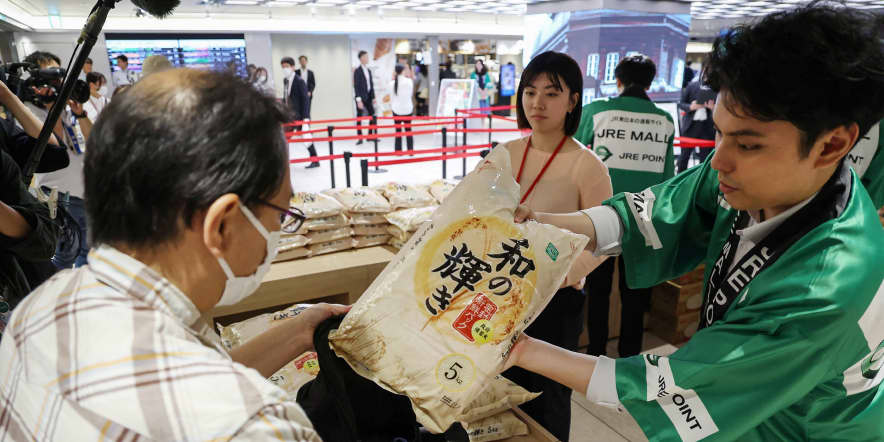Japan’s Inflation Eases in June, But Economic Risks Loom Ahead
Japan’s Inflation Eases in June, But Economic Risks Loom Ahead
By
Junia Wells
Last updated:
July 18, 2025
First Published:
July 18, 2025

Photo: CNBC
Inflation Cools, But Pressures Remain
Japan’s core inflation rate dipped to 3.3% in June, easing from 3.7% in May, in line with economists’ forecasts. While the drop marks a retreat from a 29-month high, it also underscores persistent price pressures that continue to stretch consumer wallets.
This marks the 39th consecutive month that inflation has remained above the Bank of Japan’s (BOJ) 2% target, reinforcing concerns that the underlying cost structure in the country is still under strain. The headline inflation rate, which includes volatile items like fresh food and energy, also fell to 3.3% from 3.5% in May.
At the same time, the “core-core” inflation rate — which strips out both fresh food and energy and is closely tracked by the BOJ — ticked up slightly to 3.4%, up from 3.3% in the previous month, signaling that underlying inflationary trends remain stubborn.
Rice Inflation Cools After Months of Surges
A key contributor to Japan’s earlier inflation spike was the soaring price of rice, a staple of the Japanese diet. After surging by 101.7% year over year in May, rice price growth moderated slightly to 100.2% in June. Although still extremely elevated, the easing is attributed to the Japanese government’s release of emergency rice stockpiles in early 2025.
The spike in rice prices had been building over several months due to poor harvests in 2023 and supply chain constraints. Between January and May 2025, rice inflation accelerated sharply, peaking in May. The government’s intervention appears to be having a stabilizing effect, but prices remain well above historical averages.
Analysts React: Outlook Mixed
Harumi Taguchi, Principal Economist at S&P Global Market Intelligence, noted that while June’s data aligned with forecasts, Japan remains under persistent inflationary pressure, especially for goods not covered by government subsidies.
“There is some relief from rice and energy measures,” Taguchi said, “but the depreciating yen could reignite import-driven inflation. Consumer sentiment remains fragile as real wages continue to decline.”
Similarly, Krishna Bhimavarapu, Asia-Pacific Economist at State Street Investment Management, welcomed the easing figures but flagged growing complications. “Higher U.S. tariffs, combined with a weak yen and sluggish wage growth, are creating a perfect storm for household spending,” he said. Bhimavarapu projects Japan’s GDP to grow by just 0.4% year over year in 2025, with downside risks building into the second half of the year.
Tariff Tensions and Political Volatility
Adding to the macroeconomic uncertainty are trade tensions with the United States. U.S. President Donald Trump recently announced that no trade deal with Japan is expected, escalating concerns of higher tariffs. Japan is already subject to a 25% tariff on automobile exports to the U.S., its largest export sector, and another 25% tariff is set to take effect on August 1.
These tariffs come at a time when Japan’s GDP contracted 0.2% in the first quarter of 2025, its first decline in a year, largely due to weaker exports. With trade volumes at risk and the yen under pressure, Japan’s export-driven recovery remains fragile.
Adding to this uncertainty is political risk. Japan is set to hold Upper House elections on July 20, with Prime Minister Shigeru Ishiba’s coalition at risk of losing its majority, according to Nikkei. Market analysts warn that a loss of political stability could fuel volatility in bond and equity markets, especially if fiscal stimulus plans are stalled or revised.
Final Thoughts: Temporary Relief or Turning Point?
Japan’s June inflation report offers a glimmer of relief, but the economic terrain ahead is far from stable. While government interventions on food and energy prices have helped cool headline figures, deeper structural pressures — such as a weakening yen, stagnant wages, and geopolitical headwinds — continue to weigh on Japan’s fragile recovery.
Whether this inflation downshift marks the start of a more stable trend or simply a pause before renewed pressure remains to be seen. Investors, policymakers, and consumers alike will be watching closely in the months ahead.
Popular articles
Subscribe to unlock premium content
Kylie Jenner’s $420M Beauty Empire Unravels: Inside the Stunning Fall of a Social Media Mogul

Britain’s Economic Decline: From Global Powerhouse to Financial Strain

Trapped by Perfection: How AI Beauty Filters Are Rewiring Our Faces—and Our Minds

Kylie Jenner’s $420M Beauty Empire Unravels: Inside the Stunning Fall of a Social Media Mogul

Britain’s Economic Decline: From Global Powerhouse to Financial Strain

Kylie Jenner’s $420M Beauty Empire Unravels: Inside the Stunning Fall of a Social Media Mogul









